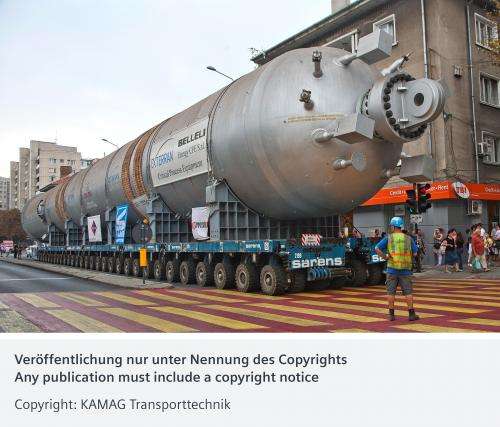Precision for huge transportation loads

A new, robust control system from Siemens allows huge loads to get to their destinations better. The gigantic loads (bridge components, drilling platforms, and booster rockets for satellites) often weigh thousands of tons and are transported on multi-axle platforms that are arranged in tandem or side by side. When traveling, hundreds of wheels have to accelerate, brake, or turn at the same time and with deviations of no more than a few millimeters. The hydraulics of each individual axle are operated by a remote control system. The new K24 model series from Kamag Transporttechnik accomplishes this using industrial system controls from Siemens, because they meet the high reliability and maintenance requirements and are available worldwide.
It looks almost like a ballet when the wheels of several transportation modules turn by 90 degrees simultaneously in order to take their loads out of the parking space. The combined platforms proceed at a walking pace, accompanied by technicians on foot, who remotely control all axles. The individual transport modules are either fixed to one another or only connected through a data cable. Because such transports require highways to be closed down, the time schedules have to be adhered to at all costs. This means that the individual axles have to be operated with complete reliability, even if the weather is rough or the vehicle has to travel through areas in which there is electromagnetic interference.
Automation technology has to meet demands that are similarly high. That's why the transportation platforms contain Simatic automation technology such as that used in industrial applications worldwide. Moreover, the components are installed as reinforced Siplus modules so that loads can be reliably transported even in extreme cold or heat. These components are impervious to moisture, such as the condensation created when a vehicle moves from a warm hall into the cold outside air.
The individual platforms' control units are networked by means of the Profinet communications standard. The hydraulic valves are operated through a CANopen interface module contained in the decentralized periphery. All of the components are designed to withstand high intensity electromagnetic interference caused by nearby machinery, radio transmitters, or radar systems. This high level of reliability is due in part to the fact that all of the components come from Siemens' Totally Integrated Automation range and are configured to match one another.
The use of standard industrial control units also has the advantage that the system can be remotely maintained through the Internet and that the components and services are available worldwide. Both of these considerations are important because the transportation platforms are used around the globe and are often sent to new locations to carry out tasks for specific projects.
Provided by Siemens





















